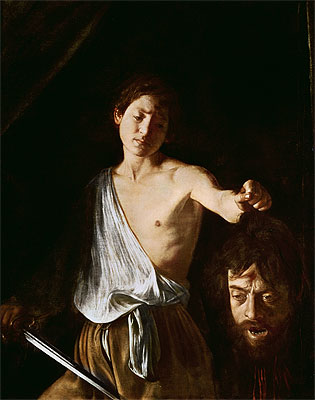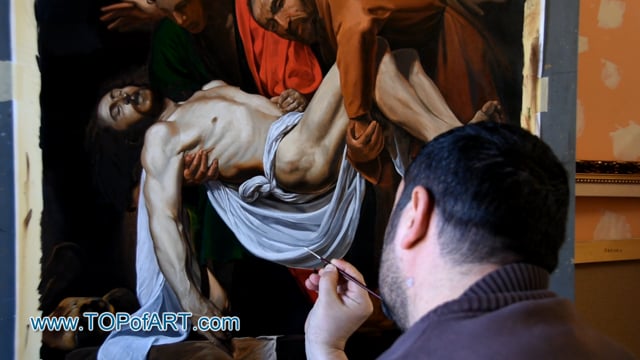David with the Head of Goliath, 1606 Michelangelo Merisi da Caravaggio (1571-1610)
Location: Galleria Borghese Rome ItalyOriginal Size: 125 x 101 cm


Recreating Caravaggio: A Video Journey into Museum-Quality Reproductions by TOPofART
Video showcasing the process of hand-painting a Caravaggio masterpiece with the utmost precision and care for detail.
Oil Painting Reproduction
If you want a different size than the offered
Description
Painted by European Аrtists with Academic Education
Museum Quality
+ 4 cm (1.6") Margins for Stretching
Creation Time: 8-9 Weeks
Creation Process
We create our paintings with museum quality and covering the highest academic standards. Once we get your order, it will be entirely hand-painted with oil on canvas. All the materials we use are the highest level, being totally artist graded painting materials and linen canvas.
We will add 1.6" (4 cm) additional blank canvas all over the painting for stretching.
High quality and detailing in every inch are time consuming. The reproduction of Michelangelo Merisi da Caravaggio also needs time to dry in order to be completely ready for shipping, as this is crucial to not be damaged during transportation.
Based on the size, level of detail and complexity we need 8-9 weeks to complete the process.
In case the delivery date needs to be extended in time, or we are overloaded with requests, there will be an email sent to you sharing the new timelines of production and delivery.
TOPofART wants to remind you to keep patient, in order to get you the highest quality, being our mission to fulfill your expectations.
We not stretch and frame our oil paintings due to several reasons:
Painting reproduction is a high quality expensive product, which we cannot risk to damage by sending it being stretched.
Also, there are postal restrictions, regarding the size of the shipment.
Additionally, due to the dimensions of the stretched canvas, the shipment price may exceed the price of the product itself.
You can stretch and frame your painting in your local frame-shop.
Delivery
Once the painting David with the Head of Goliath is ready and dry, it will be shipped to your delivery address. The canvas will be rolled-up in a secure postal tube.
We offer free shipping as well as paid express transportation services.
After adding your artwork to the shopping cart, you will be able to check the delivery price using the Estimate Shipping and Tax tool.
Museum Quality
The paintings we create are only of museum quality. Our academy graduated artists will never allow a compromise in the quality and detail of the ordered painting. TOPofART do not work, and will never allow ourselves to work with low quality studios from the Far East. We are based in Europe, and quality is our highest priority.
Additional Information
Caravaggio employs a bold yet limited color palette. Deep umber tones dominate the background, creating an enveloping darkness that draws all focus onto the figures. The few highlights—muted flesh tones and the sheen of fabric—guide the viewer’s gaze toward the interaction between living youth and lifeless countenance. This controlled modulation of light and shadow amplifies both the painting’s psychological tension and its spiritual subtext. Caravaggio’s brushwork is direct, with minimal visible layering or underdrawing; the transitions between light and dark are confidently rendered, reinforcing the sense of immediacy. The seemingly stark setting empties any external distraction, compelling attention toward the figures’ expressions, the symbolic weapon, and the haunting gaze of Goliath.
The composition underscores an unsettling intimacy between victor and victim. David’s partly extended arm visually binds the two figures, bridging the space across the picture plane. There is scant background detail; instead, the painter relies on the diagonal thrust of the sword and the subtle tilt of Goliath’s head to balance the scene. Historically, this work has been associated with Caravaggio’s attempts to appeal for clemency from Cardinal Scipione Borghese, who possessed the authority to grant him pardon for his crimes. The notion that the artist painted Goliath’s features as a self-portrait complicates the subject of triumph, suggesting an internal dialogue between punishment and redemption. Scholarly debates over the painting’s exact date—placed between 1605 and 1610—highlight both Caravaggio’s transitional style and the personal circumstances shaping his artistic output. The laconic composition, coupled with the deliberate brush handling, points to a period in which his direct approach to realism became ever more charged with emotion, making the quiet drama of David’s conflicted expression an essential focal point in this nuanced biblical narrative.




